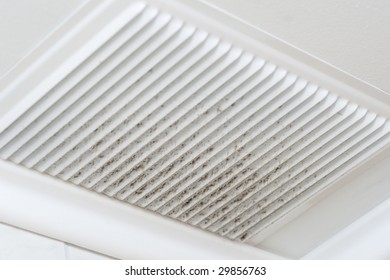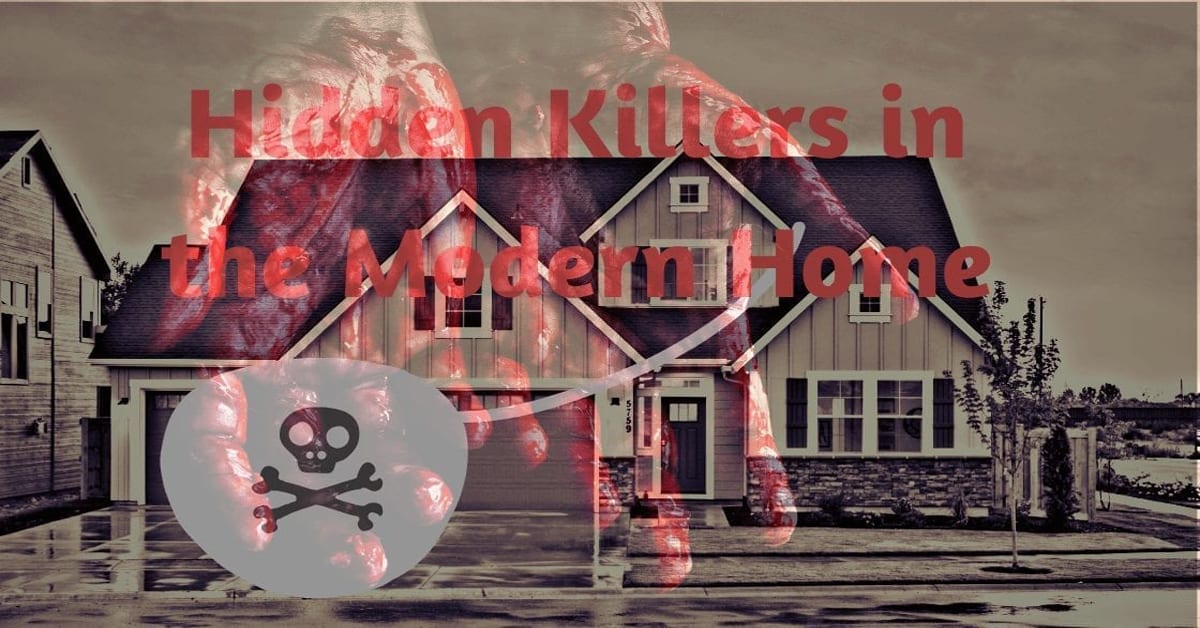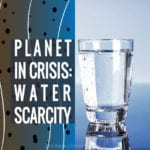What makes a home a haven is the sense of warmth, of comfort, of belonging that it creates. That will naturally be different for everyone, as individual personalities and tastes come into play. It is also about love, security, safety and faith.

For many people and their families, home is a happy place to share with those they love and retreat from the outside world but many homes aren’t as safe as people think with hidden killers lurking around every corner.
There are a shocking number of ways you can inadvertently end up with a deadly killer in the home, and I’m not talking about the home invader type. Some common mistakes have grave costs, and it’s essential to stay up to date on what’s safe to use on an everyday basis.
Hidden killers in the modern home
Not to frighten out of living in your own home, but you need to look out for what could secretly kill you in the place where you should feel the safest to call your own.
Hidden killers have been around for centuries in every home, as historian Suzanna Lipscomb explored in her BBC documentary series called “Hidden Killers”. These selfsame documentaries serve as inspiration for this cautionary guide on the lethal products and killers that lurked in every room of the modern home.
Candles

According to Dr. Bina Patel of Conflict Resolution Center, candles that are not made out of 100% soy will build toxins in the air. Candles- especially with fragrances that are made with cheap wax will eventually impact how you breathe. Candles, when lit, will release chemicals – toxins in the air that may result in lung cancer. Some of us find candles to be therapeutic and it is as long as the right type of candle is purchased.
Dryer
Your dryer is another major contributor to home-hazards, especially fires. Even if you’re regularly cleaning out the lint trap, lint can build up inside of the dryer, posing a significant risk of catching aflame. If you’re not careful you could find yourself filing an insurance claim to help you replace all you lost in a house fire. Do your best to vacuum out behind or beneath your lint trap at least once a month.
Toxic Air Fresheners

According to Stacey Bollinger of Enviroscent, indoor air quality is greatly impacted by CMRs (Carcinogens, Mutagens and Reproductive Toxins) that are found in common household air freshener products such as Febreze, Glade and AirWick.
Furniture

Flame retardants are almost everywhere these days, and we mean everywhere. In the air, in water sources, in food sources, and in our homes. Chlorine and bromine are the chemical culprits here. They tend to show up in high concentrations in beds, cushions, sofas, insulation, carpet padding, and even baby strollers.
Dander and Dust Mites
Dander is organic material sloughed off of humans, pets, and other organisms. Dust mites are microscopic organisms that are common in many homes. Both of these can prompt allergic reactions in sensitive individuals and irritate asthma symptoms. Carpets, beds, blanket? People with asthma, or pets should look out for these items.
Carpets

If you have excessive carpeting and you’re not shampooing it at least twice a year, you can’t even imagine the amount of germs in there. These germs get sucked up by your vents and then float around in your home.
Pets

Pet fur is very light and easily gets sucked up by your ducts and then recirculates in your home. This is dangerous for those with allergies.
Dirty ducts

Everything suspended into the air of your home is sucked up by your ductwork and then recirculated into your home multiple times a day when the HVAC is on.
Smokers

Living with smokers actually exposes our houses to secondhand and thirdhand smoke which are definitely among the top indoor pollutants. In fact, according to Norhanie Pangulima of Centriq, just co-living with smokers the risk of getting lung cancer increases by 25%.
Molds

Other than being found in bread, molds can also be found in wider surfaces in our homes such as walls and corners. They are indoor pollutants because exposure to it can lead to dizziness, cough, allergy attacks, fever and even asthma.
Tampons

According to Dr. Christian Gonzalez, tampons can be an unknown source of toxins. Did you know on average a woman will use 11,400 tampons over 2,200 days? The vagina is a highly permeable place so what comes into contact with it must be highly considered.
The FDA lists tampons as a medical device meaning it’s not subject to the same regulations as food, drugs or cosmetics. Most of safety testing is within the industry!
Some hazardous ingredients in conventional tampons include:
Cotton: conventional cotton is considered the “dirtiest crop” due to glyphosate. 85% of tampons were found to contain this controversial chemical. Has an affinity in particular for gut bacteria. Also connected to allergies, infertility, neurodegenerative disease and cancer.
Polyester: conventionally derived from crude oil and includes pesticides. Also often a source of heavy metal Antimony and formaldehyde. Both carcinogens and toxic to many organs.
Fragrance: an ambiguous umbrella term for potentially thousands of toxic ingredients. Across multiple studies has been linked to hormone disruption, allergies/asthma, neurotoxins and carcinogens.
Dioxin: a bleach derivative. Known to be one of the most dangerous chemicals in existence. No safe level as per EPA. 2002 bleaching tactics reduced amount of dioxin. Dr. Philip Tierno, tampon expert @ NYU says the trace amounts have additive effect. Connected to immune suppression, pelvic inflammatory disease, endometriosis, miscarriage, infertility, diabetes, birth defects, cancer. Through fiber loss rayon is shed into the vagina.
Bleach
It can most likely be found in your pantry or linen closet. We’re all aware that bleach can be toxic if consumed or accidentally exposed to the skin or eyes.
According to Kalev Rudolph of Freeadvice.com, when bleach is mixed with many other common cleaners, including anything acid-based like toilet bowl cleaner or ammonia-based (such as 409), the two chemicals can create deadly chlorine gas.
Formaldehyde
While we might remember formaldehyde from our high school biology class when we dissected a frog, the most common uses of this strong-smelling, colorless gas is in the construction industry.
According to Matt Daigle, CEO and Founder of Rise, one of the unique aspects of this chemical is that it quickly breaks down into gas form at room temperature (called off-gassing), thus releasing the chemical into the air in the home. Formaldehyde is not only in cabinetry and millwork that use particleboard and plywood, but it can also be found in drywall and even electronics.
Carbon Monoxide (CO)
Carbon Monoxide (CO)* is a gas created by burning fuel. Carbon monoxide is both an outdoor and indoor pollutant, most often building up inside garages or areas where there is burning fuel. Carbon monoxide at excessive levels can result in serious health issues and even death. Luckily, many households today already have CO alarms built in so that we can take actions immediately when there is excess carbon monoxide in our air.
Common household appliances that are used every day often make our lives easier, but they also pose risks, especially when it comes to CO. Often called the ‘invisible killer,’ CO is a tasteless, invisible, and odorless gas that can be created from any fuel-burning appliance, such as furnaces, natural gas ranges, fireplaces, gas logs and even generators when used during power outage. According to Liam Bates, Co-founder and CEO of Kaiterra, 1.5 people die per day from CO poisoning.
Carbon Dioxide
Not to be confused with carbon monoxide, carbon dioxide is an atmospheric gas that is critical for life to exist on Earth. However, concentrations of carbon dioxide can rapidly increase inside buildings from human breathing, cooking, and burning candles. Buildups tend to happen in crowded, tight spaces with poor ventilation, so be sure to let in some fresh air regularly.
Digital Gadgets and Appliances
According to Maria Gath, at least 9.8 million people in America suffer from sensitivity to the energy in the air called electromagnetic radiation fields (EMF). Based on EPA’s extensive study on the matter, electric and magnetic fields (EMF) are made up of waves of electric and magnetic energy moving together (radiating) through the air.
Electric and magnetic fields (EMF) are invisible lines of force that surround any electrical device that is a physical field produced by electrically charged objects such as cell phones, appliances, microwaves, televisions, computers, lights, wi-fi and more. High levels of EMF radiation is found in homes, workplaces, schools and extends far beyond the wires and appliances. EMFs of all frequencies represent one of the most common and fastest growing environmental influences.
Chemicals seeping into the land in Denver
In Denver, there are many other killers hidden within the land itself. According to Scott Fanello of Eternaloak.com, the bedrock below Denver and the Front Range naturally contains high levels of uranium.

Radon is a byproduct of uranium breaking down in the soil beneath your home. Most people are aware of radon; however, there are a number of other hidden gases that may find their way into your home.
The two other most common ones are gases from dry cleaner spills traveling under your home and gases from gas or diesel spills traveling under your home.

When a dry cleaner spills, its main cleaning fluid, tetrachloroethene (PCE), it can contaminate groundwater and travel away from the original spill site for miles. If this travels under your home it may slowly vaporize and move from the groundwater into your basement. Like radon this can be tested for.
The same is true for spills from gas stations. The gas or diesel can travel on top of the groundwater for a good distance away from the site and may vaporize and enter your home.
Dangerous effects from exposure to toxic household items
Poisoning
Exposure to carbon monoxide can lead to accidental CO poisoning, and it is important to understand the most common indications of CO poisoning. These include headache, dizziness, nausea, chest pain and more. However, symptoms can vary widely from person to person.
Carcinogenic
Radon, dry cleaner chemicals, and some components of gas and diesel are carcinogens.
They cause a variety of health effects, like nausea, dizziness, respiratory issues. VOCs can lead to liver, kidney, and nervous system damage. It’s a good idea to check for these things when buying paint, where it’s clearly indicated whether VOCs are present and in what quantity.
Parabens have been linked to breast cancer and effects associated with hormone disruption.
Allergic reactions
Diethyl phthalate, which is used to make scents last longer, causes allergic skin reactions (contact dermatitis) and is classified as a skin sensitizer and a reproductive toxin
Respiratory issues
Exposure to formaldehyde, especially for kids, has been responsible for higher rates of bronchitis, asthma, and throat irritation.
Animal death
You, for example, may like the scent of Pine-Sol. But the phenol in it can kill your cat even through a small exposure like walking through a puddle of it.
How can you make a home safer?
Go natural.
Many household products contain dangerous, carcinogenic chemicals. Luckily, there are substitutes available for your use to limit the toxic substances released into your air. When possible, opt for natural household products and cleaners, and always check the ingredient list.
- Pablo Solomon advises the use of natural products with proven quality and safety in construction, upgrades, repairs and for household needs.
- He also says, “Open your windows when you can.”
- Dr. Lily Kiswani recommends putting ‘air purifying’ plants in the house for whatever they are worth.
Remove any that might pose a risk.
- Store all cleaning products, paints, pesticides and harmful chemical substances in a secure location that cannot be reached by children.
- Sharp objects such as knives, rakes, saws should be stored away in a safe place in the kitchen or garage.
- For the safety of the family, especially young children and the elderly, staircases should be maintained with quality lighting and sturdy handrails and steps. You can also install safety gates at the top and base of the staircase to prevent young children from falling.
Avoid plastics
Avoid purchasing plastics that contain toxic chemicals. Ensure children’s toys are age-appropriate by checking the safety guideline on their packaging. According to Nicholas Failla of Urban AU, toxic plastics and chemicals can be a choking hazard and may cause illness or death if consumed.
Regular maintenance
- Ensure your heaters and home security systems are maintained annually.
- You can maintain your HVAC system properly and perhaps add more effective filters.
- Regularly check for mold and employ deep cleaning services every month.
- Chris Burger from Entire Duct Cleaning recommends regular duct cleaning.
Install safety detectors in your home
Smoke detectors should be installed in kitchens, living areas, hallways, bedrooms and basements.
The easiest and best way to detect a dangerous leak in your home is by having a working CO alarm. To maintain a safe environment, Kidde urges homeowners to install CO alarms on every level of the home, outside sleeping areas and in living rooms and bedrooms. Although CO poisoning is preventable with working alarms, only 50 percent of homes in America have an alarm.
Invest In An Air Purifier
One of the most common solutions to indoor air quality issues, air purifiers help strain and remove air pollutants from your home. These devices are very beneficial in improving your air quality, as they directly remove pollutants instead of diluting them.
Get An Air Quality Monitor.
When it comes to indoor air quality, utilizing an air quality monitor is essential in maintaining your indoor environment and maximizing your other gadgets.Air quality monitors, like the Laser Egg from Kaiterra, complement air purifiers. While air purifiers are very beneficial, they can’t differentiate between what has been removed and what pollutants may still be floating around. This is where an air quality monitor comes in. Used in conjunction with an air purifier, air quality monitors detect pollutants in your air, letting you know when you need to turn on your air purifier or open the windows.
Say No to Smoke.
Smoking cigarettes releases dangerous chemicals, like formaldehyde and benzene, into the air and your lungs. The best policy is to avoid smoking inside your home to protect you and your loved ones. If you must smoke indoors, be sure to open a window and vent out foul toxins.
Have your home tested by an environmental professional
You can have your home inspected by a reputable company that specializes in such inspections.
Have your water tested and if needed install proper filters for your drinking water.
If you live in the Front Range of Colorado or one of the other EPA Zone 1 areas, you should have your home tested for radon. If you live in Colorado, compare your home’s location to the location of nearby spills using the Colorado Department of Public Health and Environment’s spill map.

If you don’t live in Colorado check your state’s health or environmental department’s website for a similar map. Lastly, if you see something on one of these maps that’s concerning get your home’s air tested by a local environmental professional. They can also help with ways to fix the problem if the tests come back at unsafe levels.
Conclusion
The best way to make your home safer is to educate yourself. Then, you’ll know which products to avoid in your home with your unique family situation. Next, learn alternatives, be they natural like peppermint oil to
deter ants, or safer brands and products to use.
Above all, create a home life based on love, respect, achievement. support , faith and forgiveness. Be positive and reject fear and negativity.





2 Comments
Leave a Reply2 Pings & Trackbacks
Pingback:3 Simple Ways To Go Green For Earth Day -
Pingback:Zero Waste Home Renovation Guide - Zero Waste Lifestyle System